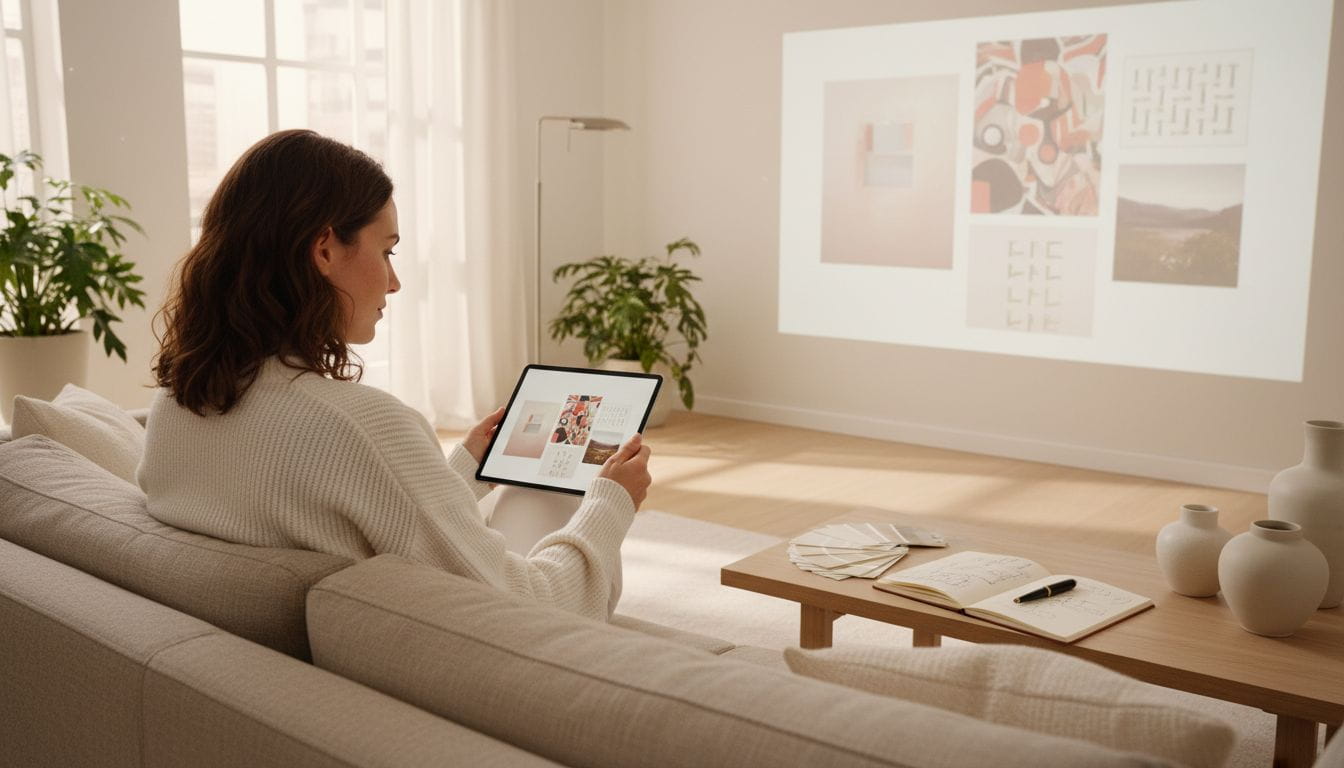
Decorating your living room with art: Your unique style
Share
Nearly 80 percent of people want a living room that reflects their personality. By carefully selecting and placing art, you can not only beautify a room but also significantly influence its atmosphere and mood. The right combination of colors, formats, and emotions ensures that your living room is more than just decorative – it becomes a vibrant expression of your own story and creates a unique living experience.
Table of contents
- Step 1: Analyze the space and atmosphere
- Step 2: Choose art with meaning
- Step 3: Combine formats and styles harmoniously
- Step 4: Arrange artworks strategically on the wall
- Step 5: Check the effect in everyday life
Quick summary
| Main point | Explanation |
|---|---|
| 1. Analyze the room and atmosphere | Pay attention to the atmosphere and color scheme of your living room. This significantly influences the placement of art. |
| 2. Choose art with meaning | Choose works that evoke personal emotions and tell your story. Art should be more than decoration. |
| 3. Harmoniously combine different formats | Use a central anchor structure and vary sizes and styles for an appealing composition. |
| 4. Arrange artworks strategically on the wall | Position artworks precisely near eye level for maximum impact and use dynamic arrangements. |
| 5. Check the effect in everyday life | Observe how light and mood influence the art in everyday life, and adjust the arrangement accordingly. |
Step 1: Analyze the space and atmosphere
Before placing artwork in your living room, you must carefully analyze the space and its atmosphere. This initial phase is crucial for a harmonious and meaningful integration of art into your living environment.
The spatial analysis begins with a careful examination of the existing atmosphere and color scheme. According to DIY and home improvement guidelines, you should pay particular attention to the positioning of artworks. Museums recommend that the center of the painting be between 1.45 and 1.60 meters above the floor, with two-thirds of the painting positioned below and one-third above eye level.
When analyzing your space, consider whether the artwork is primarily viewed while seated or passing by. Color plays a crucial role: kickinger-bau points out that warm colors make rooms appear smaller and cozier, while light walls and ceilings make rooms seem taller. Choose artwork that supports and enhances this spatial effect.
An important tip: First, take photos of your living room and experiment digitally with different art placements. This way, you can test the effect beforehand before making final decisions. Observe how the light changes the artwork and the room throughout the day.

Step 2: Choose art with meaning
Choosing art for your living room goes far beyond an aesthetic decision. It's about finding pieces that convey a deeper emotional connection and personal meaning. Art should be more than a decorative element; it should tell a story that speaks to you.
When selecting artwork, I recommend first using your own feelings and life experiences as a compass. "7 Ways to Discover the Meaning of Canvas Prints" offers excellent insights into how artwork can be more than just decoration. Look for images that reflect your personality, mystical depictions, symbolic compositions, or works that evoke a special memory or emotion within you.
Pay attention to details such as color palette, style, and emotional resonance. A work of art should not only please your eye but also touch your soul. Experiment with different styles—symbolic art, abstract compositions, or surrealist depictions—and observe which works evoke a deeper connection within you. The art you choose will become a window to your inner world and create a unique atmosphere in your personal space.
Step 3: Combine formats and styles harmoniously
The art of harmoniously combining artworks of different formats and styles requires a trained eye and an intuitive approach. The goal is to create a visual symphony that reflects your personality while forming an aesthetic unity.
Start with a centerpiece as the focal point of your composition. "7 Unique Benefits of Art Prints" recommends combining different sizes and frame formats to create dynamism and depth. Experiment with a large main image in the center and smaller works around it. Look for a common thread, such as color palette, imagery, or thematic connections between the artworks.
A professional tip is to consider the golden ratio when arranging your artwork. Group your pieces to create visual balance. Avoid symmetry and rigid arrangements. Instead, create an organic composition that generates movement and interest. The right balance between different styles, such as abstract works, photographs, and symbolic representations, can create an incredibly vibrant and personal space.
Step 4: Arrange artworks strategically on the wall
The precise placement of artwork can transform the entire character and atmosphere of your living room. It's not just about hanging pictures, but about creating a visual narrative that reflects your personal style and emotions.
According to the DIY and home improvement website, there's a scientific approach to wall design. Ideally, the center of the artwork should be positioned between 1.45 and 1.60 meters above the floor. Consider whether the artwork will primarily be viewed while sitting or standing. A large piece can serve as an anchor point, around which smaller pictures or photographs can be rhythmically grouped.
Use paper templates or digital visualization tools to test different arrangements before drilling the final holes. Experiment with varying spacing and orientations. An unexpected tip: experiment with asymmetrical arrangements. Instead of a perfectly straight line, slight shifts and unexpected distances can create a dynamic and vibrant wall composition that magically draws the eye and brings your artistic vision to life.
Step 5: Check the effect in everyday life
After you have carefully selected and arranged your artwork, the most important part of the creative journey begins: checking its actual impact in daily life. Art is not a static decoration but a dynamic element that can change with your moods and life stages.
Take time for conscious observation. Observe how the artworks present themselves throughout the day under different lighting conditions. Morning sunlight can highlight entirely different nuances and moods than the subdued evening light. "Art as a form of expression" underscores how artworks can function as emotional mirrors and be reinterpreted depending on perspective and time of day.
A professional tip is to take photos of your wall decor and compare them over a few weeks. Note your emotional reactions and be prepared to make adjustments. Art thrives on change and development, just like you. Sometimes this also means having the courage to swap or rearrange pieces to authentically reflect your current phase of life.
Give your living room a unique soul with art from Curiocanvas
The challenge of creating a personal and harmonious atmosphere in your living room with art requires pieces that not only decorate but also evoke emotions and tell your story. This is precisely where Curiocanvas comes in: Our selection of poetic and symbolic wall art combines visual beauty with profound feelings. Discover art that acts like a mirror to your soul and lends your space a truly special meaning.
Our wall art collection is the perfect starting point for adding artistic touches.

Let your walls speak and create an atmosphere with Curiocanvas that reflects your personality and evokes new emotions every day. Visit our shop now and begin your journey to a living room full of meaning and style. Also, browse our The Kiss & Lovers collection for inspiring artwork that will transform your living spaces.
Frequently Asked Questions
How do I analyze the atmosphere of my living room for art placement?
To analyze the mood of your living room, consider the color scheme and the room's atmosphere. Take photos and experiment with digital layouts to see how different artworks can influence the ambiance.
Which works of art are suitable for my living room?
Choose artworks that have personal meaning for you and reflect your emotions. Experiment with different styles that emphasize your personality, such as abstract or symbolic works.
How do I harmoniously combine different art styles?
Start with a central piece and combine different sizes and formats to create visual depth. Ensure the artworks share a common color palette or thematic connections to create a harmonious composition.
How high should I hang artwork on my wall?
The center of the artwork should ideally be positioned between 1.45 and 1.60 meters above the ground. Consider whether the artwork will be viewed while sitting or standing to determine the ideal placement.
How do I check the effect of the art in my living room?
Observe how the artworks appear throughout the day under different lighting conditions. Take time to document your emotional reactions and make strategic adjustments to achieve the perfect effect.
What can I do if the art doesn't leave a positive impression?
If the artwork doesn't have the desired effect, don't hesitate to rearrange it or replace other pieces. Make sure the art authentically reflects your current stage of life, and experiment with different arrangements.

